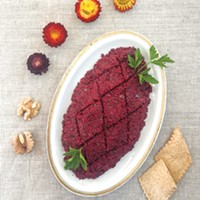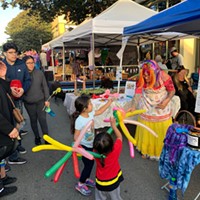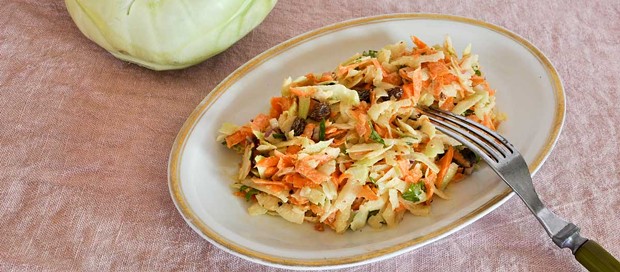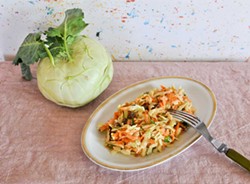[
{
"name": "Top Stories Video Pair",
"insertPoint": "7",
"component": "17087298",
"parentWrapperClass": "fdn-ads-inline-content-block",
"requiredCountToDisplay": "1"
}
]
It is hard to pass by a basket of kohlrabi without stopping. Pale green or purple, this vegetable naturally attracts your gaze with its bulbous enlarged stem. The name kohlrabi comes, via German, from the Italian cavolo rapa and literally means turnip cabbage. It is not a turnip, though, but a cultivar of Brassica oleracea, the same species as cabbage, broccoli, cauliflower, kale and all those delicious vegetables we know are good for us.
If you have not been properly introduced to it, kohlrabi may look a bit scary. So when Kelsey Perone of Rain Frog Farm told me she had a favorite recipe for kohlrabi to share, I nodded with enthusiasm — I love when I can introduce an overlooked vegetable to a larger audience.
Kohlrabi is so versatile that once you start appreciating it, you will be putting it into your shopping basket regularly. You can eat it raw, not only in the slaw version presented on this page, but in salads or cut into sticks to snack on. It goes well into soups and stews, you can shred it to make fritters or slice and grill it, or cube and roast it.
Kohlrabi is a cool weather crop, so it grows well in spring, summer and fall here on the North Coast. If there are still leaves on the specimen you buy, don't discard them — they are edible and can be used like you would collard greens or kale. The skin, which you peel off when you prepare kohlrabi, has the texture of broccoli stems and the inside is a creamy white. Kohlrabi's crisp texture is also reminiscent of a broccoli stem (which I often eat while I chop broccoli, the cook's reward), with a flavor that is somewhat sweeter and slightly radish-like.
Besides kohlrabi, owner/farmers Kelsey and Benjamin Perone grow a variety of produce at the certified organic Rain Frog Farm (located near Blue Lake) including lettuce, kale, spinach, chard, collards, broccoli, cabbage, Brussels sprouts, fresh herbs, tomatoes, summer and winter squashes, cucumbers, snow peas, green beans, heirloom dry beans, beets, turnips, radishes, leeks, shallots and peppers, as well as flowers and nursery starts.
You can find Rain Frog Farm's stand at farmers markets year-round on the Arcata Plaza on Saturdays, at the summer farmers markets in Eureka (Old Town on Tuesday mornings and Henderson Center on Thursday mornings), in Fortuna (Tuesday afternoons) and McKinleyville (Thursday afternoons). See details in the Journal's Calendar and the Growers Associations website www.northcoastgrowersassociation.org. The farm also supplies produce to local grocery stores and restaurants.
Kohlrabi Slaw
Serves 4.
I use raisins and plump them up for half an hour or so in 2 tablespoons of lukewarm water, then drain them and add them to the slaw. I also like to use fresh red onion.
Ingredients:
2-3 cups grated peeled kohlrabi
1 carrot, grated
1/4 cup diced onion
1/3 cup dried raisins or cranberries
3-4 tablespoons fresh cilantro, dill, parsley or basil, finely chopped
For the dressing:
1/4 cup mayonnaise
1 tablespoon cider vinegar
1 tablespoon sugar
salt and pepper to taste
Instructions:
To prepare the kohlrabi for grating: After cutting off leaves and stems (remember, the leaves are edible), cut the kohlrabi in half lengthwise, then into quarters. Cut away the bottom corner and peel off the tough outermost layer.
Prepare the vegetables and place them in a serving bowl. In another small bowl, whisk together the dressing ingredients. Pour the dressing over the vegetables and toss well. Serve.
This recipe can easily be halved and you can just as easily eat two portions (I know because I have done it repeatedly).
Simona Carini also writes about her adventures in the kitchen on her blog www.pulcetta.com.
Speaking of...
-

Mexican and Masala
Feb 29, 2024 -

Spreading Vegetable Joy
Jan 18, 2024 -

Eureka Friday Night Markets are Here
Jun 29, 2023 - More »
more from the author
-
More than a Farmstand
Sea Goat grows into a McKinleyville hub
- Jul 18, 2024
-
When Nature Gives You Rain, Visit a Waterfall
A hike to Trillium Falls and beyond
- May 16, 2024
-
A Green Dish for Earth Day or Any Day
- Apr 18, 2024
- More »

































